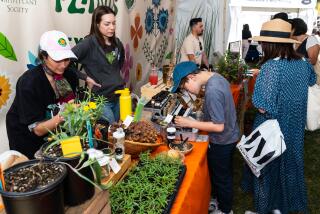A beauty with a past
- Share via
Tom NUCCIO simply can’t contain himself. He is deliriously in love with camellias. You see it in his quick smile and sun-ruddied cheeks, in his step as he bounds through his family’s nursery in the foothills of Altadena.
Tom is not alone. Brother Jim, cousin Julius and their fathers, Julius and Joe, are all infatuated with the same flowering shrubs. After nearly 70 years of growing and breeding camellias, their floral progeny are numerous. And the Nuccio family is world famous.
Since 1935, Nuccio’s Nurseries has introduced hundreds of new camellias, including the ‘Guilio Nuccio,’ considered by many to be the finest camellia cultivar of all time. Quite an honor, considering the competition.
Landscape designer Russell Page deemed camellias “the most magnificent of evergreens for a frost-free climate,” and few gardeners will dispute him. Few landscape plants are as versatile, or as floriferous with so little care.
Without fail, by Valentine’s Day camellias are strutting their stuff, with blossoms of icy white, intense red and heartwarming tints of pink and rose.
Adoration of camellias is nothing new. In China, Japan and other parts of southern Asia, where some 200 species are known to grow wild, camellias are revered for their resilience, flowers and oil-rich seeds. Ancient specimens grace Buddhist temples. And one species, Camellia sinensis, has rocked the world: It’s the source of tea, green or fermented.
Ornamental camellias were unknown in Europe and America until the 1700s, when all who saw their exotic blossoms were swept off their feet. Those who could afford them grew them under glass, safe from the winter cold. Camellias as cut flowers and boutonnieres were all the rage. Like many things rare and beautiful, they came to signify status and, in time, deep romantic passion.
Camellias arrived in California with the Gold Rush, and, by the end of the century, intrepid interior valley gardeners were growing them outdoors with great success.
Their popularity surged in the 1930s, along with the state’s population. The San Gabriel Valley became a hotbed of camellia activity. Two world-renowned collections were established, one at the Huntington estate and another under the native oaks at Manchester Boddy’s spread, now Descanso Gardens. Gardeners and breeders in mild-winter climates around the globe joined in the love fest. New plants flooded the market and became landscape standards.
Modern camellia cultivars, estimated in the thousands, arise either from chance, as in unexpected seedlings and spontaneous “sports,” or from hybridization by bees (their natural pollinators), or by folks such as the Nuccios.
Bees aren’t picky; they’re attracted to pollen-rich stamens at the golden heart of each flower. Human breeders are more particular, mating plants with great vigor, unusual colors or forms. With patience and time, good parentage yields exciting results.
Camellia japonica is a fine breeder, strong and variable, with most but not all hybrids claiming it as one of its parents. Characteristics from other species are easily spotted in five of the new introductions from Nuccio’s.
Two of their japonica selections are really turning heads. ‘Nuccio’s Bella Rossa’ (Plant Pat. No. PP13023) is a vigorous plant that produces long-lasting bright red flowers over an unusually long season, from November into March. ‘Candy Apple’ flaunts loose, voluptuous tomato-red blossoms on a bushy plant with dense, dark foliage.
‘Buttons ‘n Bows’ displays its Camellia saluenensis genes with little leaves and masses of small, pink, tightly formed blossoms on a very compact bush -- a colorful choice for containers.
‘High Fragrance,’ a descendant of sweet-smelling C. lutchuensis, is an arching open shrub, with intricate ivory-pink flowers edged in deeper pink. “On a scent scale of 10,” says Tom Nuccio, “this one’s an 8 or 9.”
‘Buttermint’ is medium-sized, with clusters of miniature creamy white to pale yellow blossoms. Its parent Camellia kissi (a natural for Valentine’s Day) produces small scented white flowers.
Both gardeners and lovers find reassurance in the familiar, but variety keeps love alive. Though classic camellias are deservedly popular, many more warrant space in the garden.
Camellias offer surprising diversity. Habits range from tight and bushy to open and tree-like, upright or tiered, weeping, arching or spreading. The foliage varies too, in size, texture and shape, some willow-like or fishtailed, with smooth or serrated margins.
And the flowers are beguiling. Minute or large, flaring or cupped, relaxed or formal. As delicate as wild roses, as obscene as dinner-plate dahlias. Even a small collection can provide color from summer’s end through the warmest days of spring, and each group has its place in the landscape.
Common japonicas, offering the widest range of form and color, are reliable choices for formal and informal settings, as small trees or living walls. Higos (a type of japonica) are bushy with plum-like blossoms, punctuated by a wide sunburst of stamens. The leggier reticulatas, from China, are tree-like beasts with enormous flowers.
Fall-flowering sasanquas are ideal for our region. These Japanese natives require warmth and accept drought and relatively heavy soils. The flowers are simple and silken. Most are scented, like fresh tea or soft musk. They vary from upright to vining; low spreading ones make excellent ground covers.
Species camellias, unadulterated from the wild, are a collector’s delight. Camellia grijsii is a fine tall shrub with rose-like leaves and fragrant snow-white blossoms. C. japonica var. macrocarpa, the apple camellia, has tubular red flowers and large red and green seedpods. The wiry branches of C. transnokensis, Tom Nuccio’s favorite, are dotted with red buds that reveal wee white flowers.
At his nursery, an older hybrid catches Nuccio’s eye: ‘Snow Drop,’ with small but abundant pink-blushed blossoms. Next, he shows off some of the new babies: a group of rare golden-yellow hybrids from Japan. The Tama-No-Ura seedlings -- red and pink beauties with waxy white-bordered petals. He’s most excited by a buff-apricot selection with a “mixed-up name.” Beautifully shaped with sultry pink overtones, it won’t be released for a year or two.
No doubt, gardeners will fall in love.






